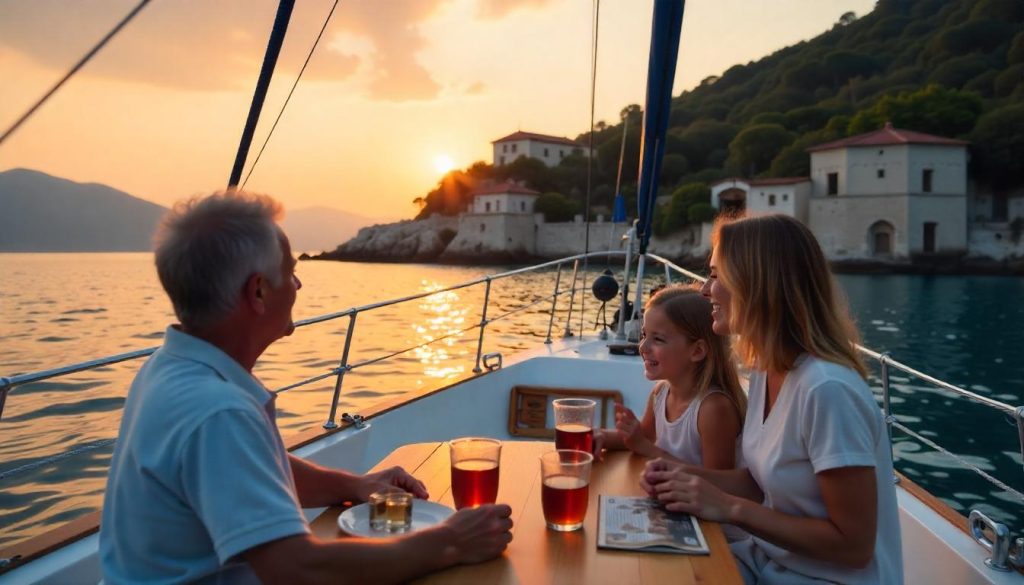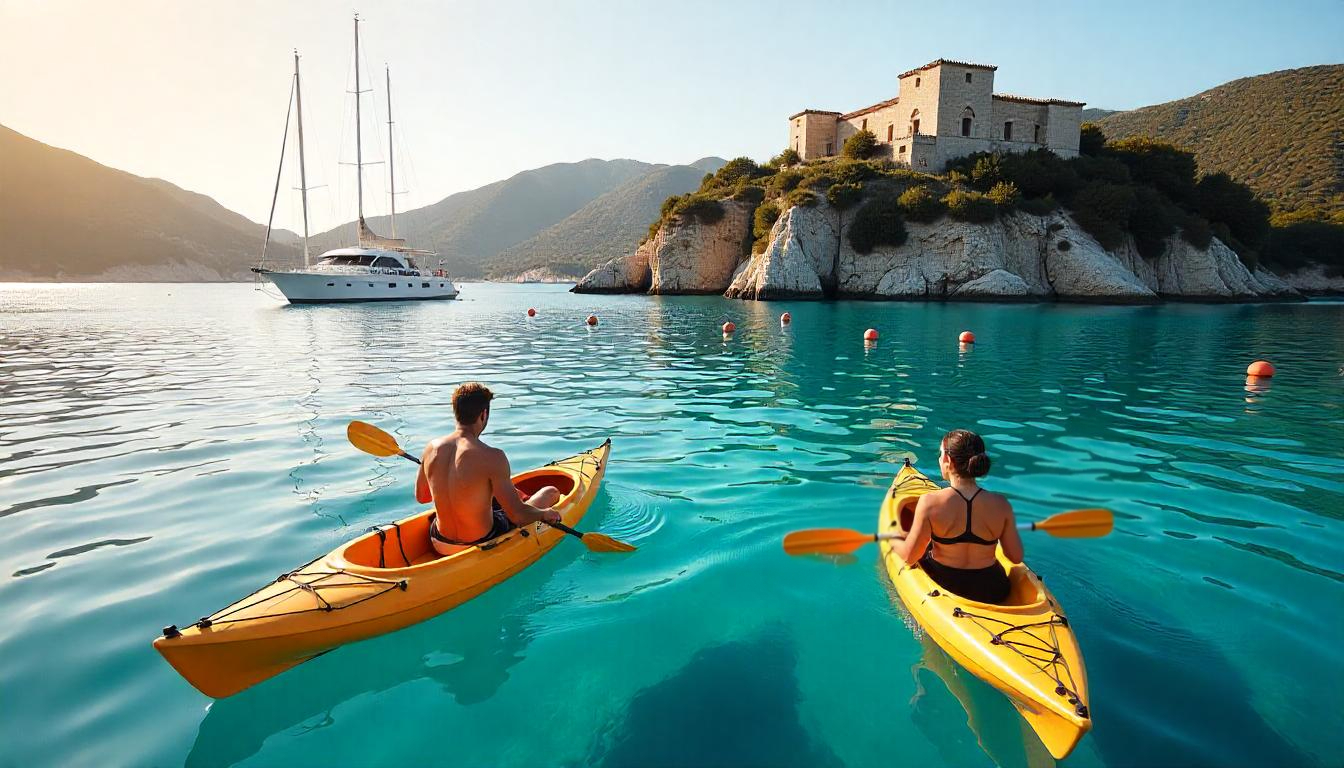Turkey’s Lycian Coast, stretching along the southwestern shores of the Mediterranean, is a treasure trove of ancient history, making yachting in Turkey Lycian an extraordinary journey through time. This region, once home to the ancient Lycian civilization, is dotted with archaeological sites, sunken cities, and rock tombs, all accessible by sea. In this article, we’ll guide you through the best historical routes along the Lycian Coast, share insights into its rich past, and provide practical tips for a seamless sailing adventure that blends history with the beauty of the Turkish Riviera.
Why Choose Yachting in Turkey Lycian Coast?
The Lycian Coast offers a unique sailing experience, combining stunning natural beauty with a deep historical legacy. For starters, the region’s calm waters and short distances between anchorages make it ideal for leisurely exploration. Moreover, the coastline is lined with ancient sites that are often best accessed by boat, providing a front-row seat to history. Consequently, yachting in Turkey Lycian allows you to immerse yourself in the past while enjoying the freedom of the sea.
The Historical Significance of the Lycian Coast
The Lycian Coast is named after the Lycians, a seafaring people who thrived here from the 15th to the 6th century BCE, leaving behind a legacy of rock tombs, amphitheaters, and cities. For instance, their unique burial practices—carving tombs into cliffs—are a testament to their reverence for the afterlife. Additionally, the region’s strategic location made it a hub for trade and conquest, with influences from the Greeks, Romans, and Byzantines, adding layers of history to explore.
Starting in Fethiye: A Gateway for Yachting in Turkey Lycian Routes
Fethiye, a bustling port town, is an ideal starting point for yachting in Turkey Lycian historical routes. The town’s marina is well-equipped, and its proximity to ancient sites makes it a perfect base. Begin your journey by visiting the Lycian rock tombs carved into the cliffs above Fethiye, a short hike from the marina. These tombs, dating back to the 4th century BCE, are shaped like temple facades, offering a glimpse into Lycian burial traditions. From Fethiye, sail to Gemiler Island, a 1-hour trip, where you can explore Byzantine ruins, including churches and a covered walkway, scattered across the island.
Exploring Gemiler Island’s Byzantine Ruins
Gemiler Island, also known as St. Nicholas Island, is believed to be a pilgrimage site linked to St. Nicholas, the inspiration for Santa Claus. For example, walking through the ruins at sunset, with the sea sparkling below, feels like stepping back in time. Transitioning from Fethiye’s rock tombs to Gemiler’s Byzantine remnants sets the tone for a journey steeped in history.
Kas to Kekova: A Highlight of Yachting in Turkey Lycian History
Kas, a charming town on the Lycian Coast, is another must-visit stop for yachting in Turkey Lycian historical routes. Sail to Kekova Island, a 2-hour journey, where the sunken city of Simena lies partially submerged due to a 2nd-century earthquake. Anchor in Üçağız Bay and kayak over the ruins, where you can see submerged walls, staircases, and amphorae beneath the clear water. The area is a protected site, so follow guidelines like using mooring buoys to avoid damaging the seabed. From Kekova, visit the nearby village of Kaleköy, accessible only by boat, where a medieval castle overlooks the sea, offering panoramic views and a small museum.
Discovering Kaleköy’s Medieval Castle
Kaleköy’s castle, built by the Knights of St. John, is a highlight of this route. For instance, climbing to the top and seeing the Lycian sarcophagi scattered around the village provides a tangible connection to the past. Additionally, the village’s small tavernas serve fresh seafood, allowing you to refuel while soaking in the historical ambiance. Transitioning from Kekova’s sunken ruins to Kaleköy’s castle ensures a day filled with historical exploration.
Demre: Ancient Myra on Your Yachting in Turkey Lycian Journey
From Kekova, sail to Demre, a 2-hour trip, to explore the ancient city of Myra, another gem for those on a yachting in Turkey Lycian historical route. Myra was a major Lycian city, known for its well-preserved rock tombs and a Roman theater that could seat 10,000 people. The tombs, carved into a cliff face, are adorned with intricate reliefs, while the theater’s stone seats and stage remain largely intact. Demre is also home to the Church of St. Nicholas, where the saint served as bishop in the 4th century CE, adding a layer of Christian history to your journey.
Visiting the Church of St. Nicholas
The Church of St. Nicholas in Demre is a pilgrimage site, with frescoes and mosaics that hint at its Byzantine past. For example, standing in the church’s quiet courtyard, you can almost feel the weight of history, from its Lycian roots to its Christian significance. Transitioning from Myra’s ancient ruins to the church offers a broader perspective on the region’s historical evolution.
Tips for Yachting in Turkey Lycian Historical Routes
Planning a historical yachting trip requires careful preparation to ensure a smooth and enriching experience. First, choose a yacht suited to your group size—a 30- to 40-foot yacht is ideal for small groups, while larger vessels offer more space for families. Next, consider hiring a skipper with knowledge of the Lycian Coast; they’ll navigate tricky areas and share insights about historical sites. Also, plan short sails—2 to 3 hours daily—to leave plenty of time for exploring ashore.
Timing Your Lycian Adventure
The best time for yachting in Turkey Lycian routes is May to October, when the weather is warm and the seas are calm. However, July and August can be hot, with temperatures reaching 35°C, so opt for May, June, or September for cooler conditions. For instance, sailing in September offers pleasant temperatures around 25°C and fewer crowds at sites like Myra. Transitioning from planning to timing ensures your trip aligns with the best conditions for historical exploration.
Safety Tips for Yachting in Turkey Lycian Coast
Safety is crucial when sailing along the Lycian Coast, especially in areas with historical significance. First, ensure your yacht has essential safety gear: life jackets, a VHF radio, and flares. Next, check weather forecasts daily—apps like Windy are reliable for tracking winds and storms. Also, be mindful of underwater hazards near Kekova, where the sunken ruins can pose a risk to your anchor. For example, using a depth sounder in Üçağız Bay can help you avoid grounding.
Respecting Protected Sites
Many sites along the Lycian Coast, like Kekova, are protected, so follow guidelines to preserve them. For instance, avoid anchoring directly over the sunken ruins and use designated mooring buoys instead. Additionally, don’t remove artifacts or disturb wildlife, such as the loggerhead turtles that nest in the area. Transitioning from safety to preservation ensures you protect the historical and natural treasures you’re exploring.
Cultural Experiences Along the Lycian Coast
The Lycian Coast is rich with cultural traditions that enhance your yachting experience. In Kas, visit the local market to buy handmade souvenirs like woven rugs or ceramics, and try a traditional Turkish breakfast of olives, cheese, and honeycomb at a seaside cafe. In Demre, engage with locals at a small taverna near Myra, where you might share a glass of Turkish tea while learning about the area’s history. Also, consider a Turkish bath, or hamam, in Fethiye for a relaxing cultural experience after a day of sailing.

Engaging with Locals in Kaleköy
In Kaleköy, locals are warm and welcoming, often eager to share stories about their village. For example, a fisherman might tell you about the Lycian sarcophagi scattered around the area, adding a personal touch to your visit. These interactions not only enrich your trip but also help you discover hidden historical spots. Transitioning from sailing to cultural engagement creates a deeper connection to the Lycian Coast.
The Cost of Yachting in Turkey Lycian Historical Routes
A week-long yachting trip along the Lycian Coast is budget-friendly. A small yacht for four people might cost $2,500 for the week, plus $500 for a skipper with historical knowledge. Add $400 for fuel and mooring fees—most bays like Üçağız are free to anchor, but marinas like Fethiye charge $50 per night. Provisions—food, drinks, and supplies—run about $400. Total: around $3,800, or $950 per person, making this historical journey affordable.
Tipy pro úsporu rozpočtu
Save by cooking onboard instead of dining out every night, using ingredients bought at local markets in Kas or Fethiye. For instance, a homemade lunch in Gemiler Bay, with produce from Fethiye, costs a fraction of a restaurant meal. Also, anchor in free bays like Butterfly Valley near Fethiye instead of marinas. Transitioning from cost to savings strategies keeps your trip economical while allowing you to focus on historical exploration.
Challenges of Yachting in Turkey Lycian Coast
Exploring the Lycian Coast by yacht can present challenges. Crowded marinas, like Fethiye in peak season, can make docking tricky—arrive early to secure a spot. Additionally, sudden winds in the Meltemi season (July-August) can make sailing choppy, especially between Kas and Kekova. Some historical sites, like Kekova, have strict regulations to protect the ruins, requiring careful navigation. Nevertheless, these hurdles are manageable with preparation.
Overcoming Historical Route Challenges
Book marina spots in advance, especially in Fethiye, to avoid stress. For winds, sail early in the day when conditions are calmer, and have a backup anchorage ready—like a sheltered bay near Kas. For regulations, familiarize yourself with protected areas and use mooring buoys where required. Transitioning from challenge to solution ensures a smoother historical journey.
Why Choose Yachting in Turkey Lycian Historical Routes?
The Lycian Coast offers a rare chance to sail through history, with ancient sites at every turn. The combination of natural beauty—think turquoise waters and pine-covered hills—and historical significance creates a sailing experience that’s both educational and awe-inspiring. For history buffs, adventurers, or curious travelers, it’s a journey that brings the past to life.
A Journey Through Time
Every stop tells a story—whether it’s the rock tombs of Fethiye, the sunken ruins of Kekova, or the ancient theater of Myra. For instance, kayaking over Simena’s submerged city, with the outlines of ancient homes beneath you, feels like sailing through a living museum. This blend of history and adventure makes yachting in Turkey Lycian historical routes an unforgettable experience.
Final Thoughts on Yachting in Turkey Lycian Coast
Yachting in Turkey Lycian historical routes offers a unique way to explore the Turquoise Coast, from the ancient tombs of Fethiye to the medieval castle of Kaleköy. With careful planning, a respect for history, and a sense of adventure, you’ll uncover the stories of the Lycian Coast—one wave at a time. So, set sail, step into the past, and let Turkey’s Mediterranean shores guide you through a journey of discovery.

 Jachting v Turecku: Historické trasy podél lykijského pobřeží">
Jachting v Turecku: Historické trasy podél lykijského pobřeží">
